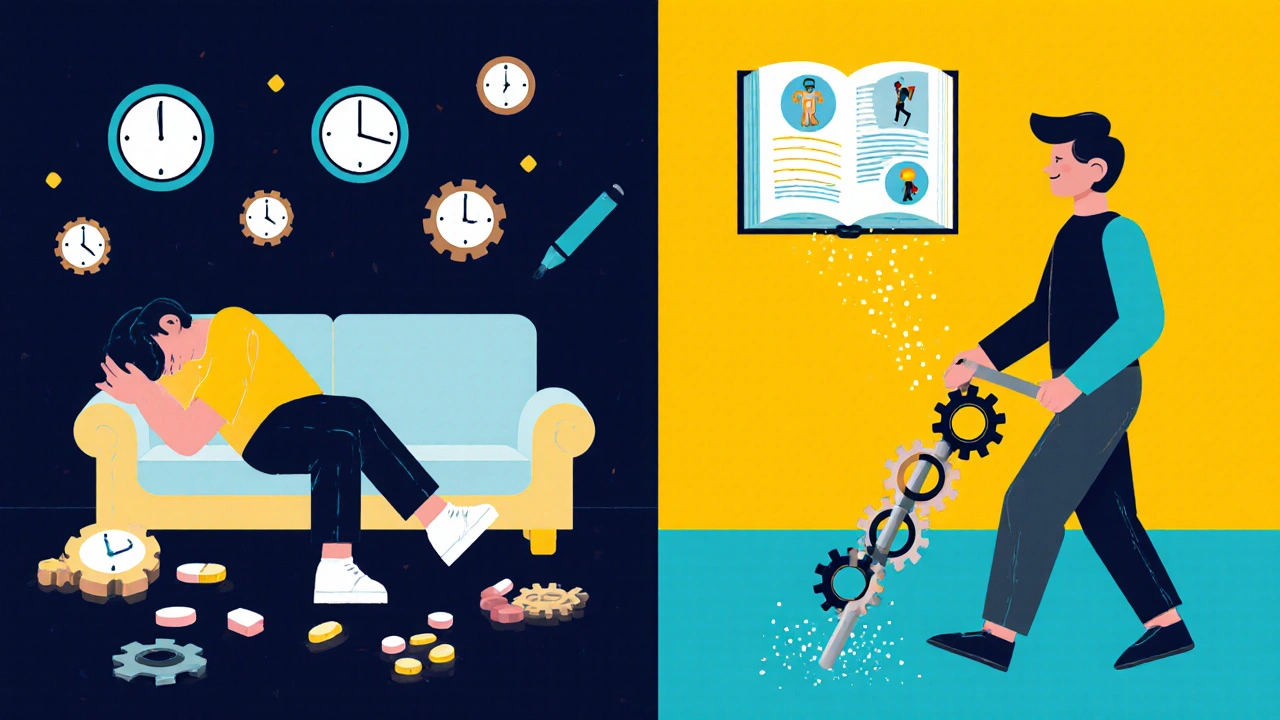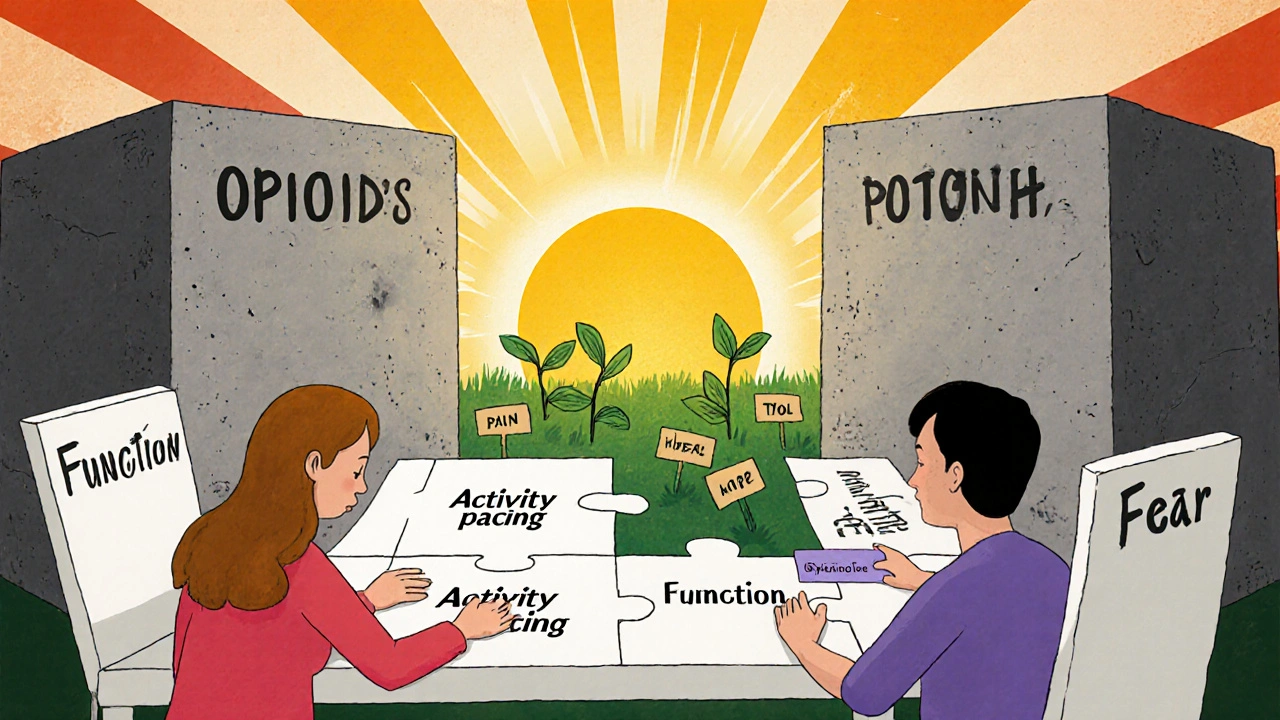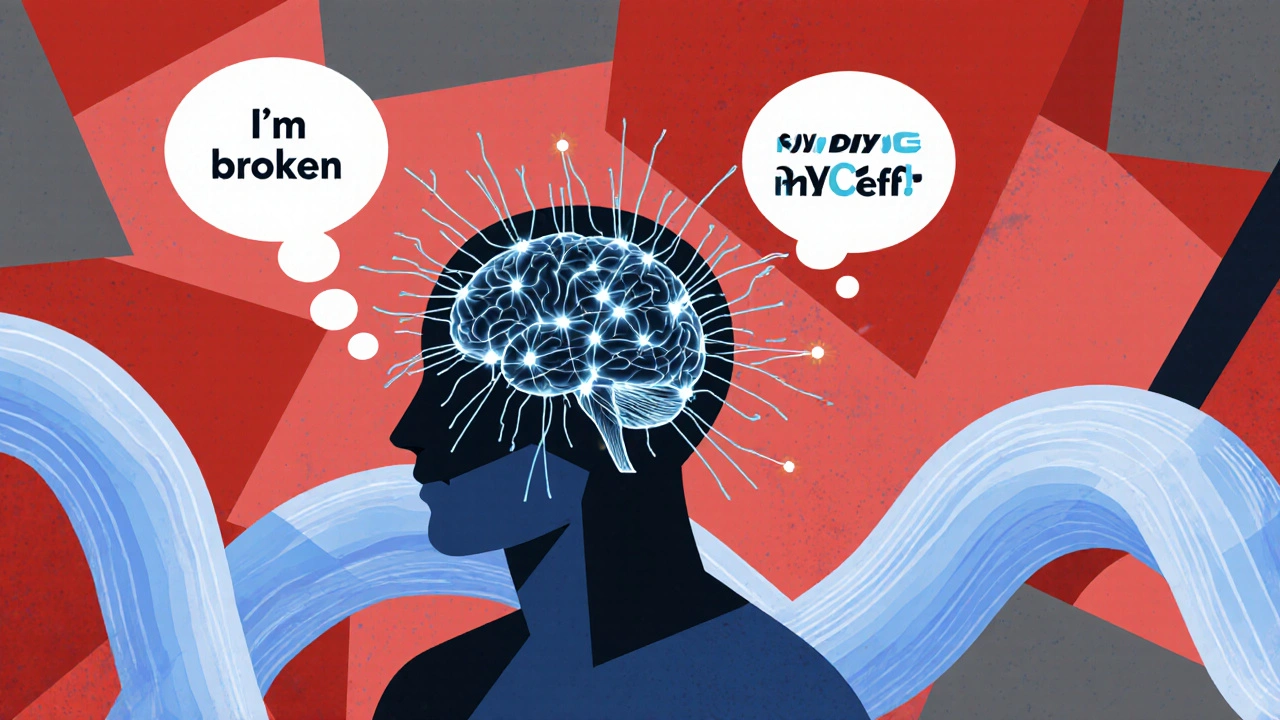Chronic pain doesn’t just hurt-it steals your sleep, your mood, your ability to move, and sometimes even your sense of control. You’ve tried medications, physical therapy, maybe even injections. But if you’re still stuck in a cycle of flare-ups, frustration, and fatigue, you’re not alone. Eight out of ten people with chronic low back pain say they’re dissatisfied with what’s been offered. What if the missing piece isn’t another pill or procedure-but a way of thinking?
What CBT for Chronic Pain Actually Does
Cognitive Behavioral Therapy for Chronic Pain, or CBT-CP, isn’t about pretending your pain isn’t real. It’s about changing how your brain reacts to it. Pain isn’t just a signal from your nerves-it’s shaped by your thoughts, emotions, and behaviors. When you’ve had pain for months or years, your brain starts to overreact. You might start fearing movement, believing you’re damaged beyond repair, or catastrophizing every twinge as a sign things are getting worse.
CBT-CP targets those patterns. It doesn’t erase pain, but it breaks the cycle that makes pain worse. Studies show it’s the most researched psychological treatment for chronic pain, backed by over 37 clinical trials. It’s not a quick fix. It’s a skill-building course for your mind.
How It Works: The Core Tools
Most CBT-CP programs run for 8 to 16 weekly sessions, each about an hour long. Whether you do it one-on-one with a therapist or in a group, the structure is the same. Here’s what you’ll actually learn:
- Pain neuroscience education: You’ll learn how pain works in the nervous system-not just in your back or knee, but in your brain. Understanding that pain doesn’t always mean damage reduces fear. This alone can lower pain sensitivity over time.
- Activity pacing: Instead of pushing through pain until you crash, then resting for days, you learn to move in small, steady doses. Think walking 10 minutes twice a day instead of 30 minutes once and being bedridden for two days. This stops the boom-bust cycle that keeps pain locked in.
- Cognitive restructuring: You’ll identify thoughts like “I’ll never get better” or “If I move, I’ll hurt myself,” and test them. Are they true? Are they helpful? Replacing them with more balanced thoughts (“I can move carefully today”) reduces stress and improves function.
- Relaxation techniques: Chronic pain keeps your body in fight-or-flight mode. Breathing exercises, progressive muscle relaxation, and mindfulness help calm your nervous system. This doesn’t make pain disappear-but it makes it easier to live with.
- Behavioral activation: Pain often pulls you away from things you love. CBT-CP helps you slowly reconnect with hobbies, social activities, or even small daily joys. It’s not about being happy all the time-it’s about rebuilding a life that matters, even with pain.
The U.S. Department of Veterans Affairs uses a standardized 10- to 12-session version of CBT-CP, with workbooks and homework. Patients who complete at least 80% of sessions are over twice as likely to see real improvement.
What the Research Says-And What It Doesn’t
Let’s be clear: CBT-CP won’t make your pain vanish. For pain intensity alone, the effect is modest. A 2023 review of 13 studies found only 25% of trials showed significant pain reduction compared to standard care. That’s why some people walk away disappointed.
But here’s what it does well:
- Reduces depression and anxiety: In 6 out of 8 studies, CBT-CP significantly lowered symptoms of depression. For anxiety, 5 out of 6 studies saw improvement. If you’re struggling with mood alongside pain, this is where CBT shines.
- Improves function and quality of life: Veterans Health Administration data shows 73% of participants reported meaningful improvement in daily function. One patient said, “Learning to pace kept me from being stuck on the couch.”
- Reduces opioid use: In a 2024 trial with 254 chronic low back pain patients on opioids, 36% of those in CBT-CP cut their daily opioid use-compared to just 17% in usual care. That’s a powerful benefit in a time when opioid risks are well known.
It’s not magic. But it’s one of the few tools that gives you back agency. You’re not waiting for a doctor to fix you-you’re learning how to manage your own response.

How It Compares to Other Options
What about mindfulness? Physical therapy? Medication?
A 2024 JAMA study directly compared CBT-CP to mindfulness-based therapy in opioid-treated chronic pain patients. At 26 weeks, both worked equally well for pain and function. Neither beat the other. But both crushed standard care.
Compared to physical therapy alone, CBT-CP doesn’t improve mobility more-but it improves emotional well-being significantly more. If you’re stuck in fear-avoidance (“I can’t bend over because it’ll hurt”), CBT helps you break through.
And compared to drugs? No side effects. No risk of dependence. No withdrawal. But it requires effort. You can’t just take a pill and forget about it. You have to show up, practice, and rewire habits.
Some studies suggest combining CBT-CP with physical therapy gives the best long-term results. One review found this combo ranked #1 for pain reduction among all non-surgical options.
Who Benefits Most-and Who Might Struggle
CBT-CP isn’t for everyone. But it works best for people with:
- Musculoskeletal pain (back, neck, joints)
- Depression or anxiety alongside pain
- High levels of pain catastrophizing (“This pain is unbearable,” “I can’t handle this”)
- Fear of movement or activity
It’s less effective for neuropathic pain (like diabetic nerve pain or post-surgical nerve damage), where nerve damage is the main driver. It also doesn’t work as well for people who believe pain is purely physical and refuse to engage with psychological tools.
And yes-some studies show mixed results. One 2023 study found no significant improvement in men or women with chronic pain. But that’s the exception. Most large reviews show consistent benefits for mood, function, and opioid reduction.
What matters most? Your therapist’s skill. Patients say 87% of their success depends on having a therapist who understands pain and can guide them without judgment.
Barriers to Getting Started
Even though CBT-CP is recommended in 92% of global pain guidelines, most people never try it. Why?
- Stigma: “Is this just in my head?” Many patients feel insulted when told pain has a psychological component. But CBT doesn’t say your pain is imaginary. It says your brain’s reaction to it can be changed.
- Access: There aren’t enough trained therapists. In the U.S., only 32% of community clinics offer CBT-CP. Veterans Health Administration facilities are better equipped-68% offer it.
- Insurance: Medicare covers only 10 sessions a year. Most protocols need 12 to 16. Private insurers vary: UnitedHealthcare covers 12, Aetna covers 8. Some don’t cover it at all.
- Time and effort: You need to commit. Skipping sessions or not doing homework cuts success rates in half.
Telehealth has helped. Video-based CBT (vCBT) is just as effective as in-person sessions, according to a 2021 study. That’s opened doors for people in rural areas or with mobility issues.

Real Stories From People Who Tried It
Reddit’s r/ChronicPain community has over 1.2 million members. A 2023 analysis of 1,200 posts showed:
- 62% had positive experiences with CBT-CP
- 47% said the biggest win was having “practical tools I can use daily”
- 38% credited it with helping them reduce or quit opioids
- 29% said it felt like “they were blaming me for my pain”
One woman, 45, with 10 years of low back pain said: “I used to think if I didn’t push through pain, I was weak. CBT taught me that pacing isn’t giving up-it’s staying in the game.”
Another man, 58, who’d been on opioids for 7 years: “I didn’t believe it would help. But after 6 sessions, I cut my pills in half. Now I walk my dog every morning. That’s something I hadn’t done in years.”
What’s Next for CBT-CP
The field is evolving. The NIH is funding $14.2 million in research to make CBT-CP more personalized-matching techniques to individual pain profiles. New digital apps are being FDA-cleared, offering guided CBT modules you can use at home.
Some clinics are testing 4- to 6-session versions for people who can’t commit to longer programs. Early results show promise, especially for reducing opioid use.
Wearable tech is also entering the picture. Imagine a device that tracks your movement and reminds you when you’ve been inactive too long-then suggests a gentle walk. That’s the future.
By 2030, experts predict CBT-CP use will triple as insurance systems shift to pay for outcomes, not just procedures. The goal? To make it as routine as physical therapy.
How to Get Started
If you’re considering CBT-CP:
- Ask your doctor for a referral to a psychologist or licensed therapist trained in Cognitive Behavioral Therapy for Chronic Pain. Look for credentials like “CBT-CP certified” or experience with pain populations.
- Check your insurance. Call and ask: “Do you cover CBT for chronic pain? How many sessions are included?”
- Consider telehealth if in-person options are limited. Many providers now offer video sessions.
- Be ready to do the work. You’ll get homework. You’ll need to track your pain, thoughts, and activities. It’s not passive.
- Combine it with movement if possible. Even light walking or stretching alongside CBT boosts results by 40%.
It’s not a cure. But for many, it’s the first time they feel like they’re not powerless.
